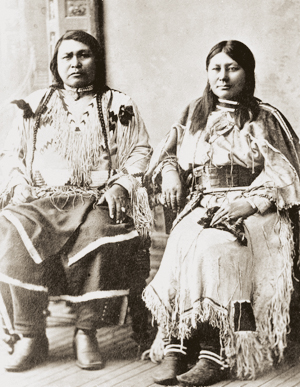Searching for Chief Ouray’s Home
“Ouray was known to have at least three homes in western Colorado…”
Story by Gail Zanett Saunders
All content © San Juan Publishing Group, Inc, All rights reserved.
[Ouray, Colorado] FOR MORE THAN 30 YEARS, Steven Baker, now partially retired, and the founder of Centuries Research, Inc. of Montrose, Colo., has been searching for the home of Ouray’s namesake. His archeology firm, started in 1977, is one of the oldest consulting archaeology firms in the United States. Baker’s professional career includes numerous investigations of Native American sites and historical Victorian settlements. Baker has directed the Uncompahgre Valley Ute Project since its inception in the 1970’s.
He conducted excavations at Chief Ouray’s 1870’s ranch near Montrose and at the second Los Pinos Indian Agency near Colona. Baker is an adjunct faculty member in the Department of Southwest Studies at Fort Lewis College in Durango and is the author of several professional articles and reports.
 Ouray (1833-1880) was a widely known Ute leader who played an important role in the early history of Colorado. He is remembered for his peacekeeping skills in negotiating treaties with the U. S. government. The federal government appointed him chief of the Ute peoples. Half Apache and half Ute, Ouray’s early years were spent in the area around Taos and Abiquiu and he was well acquainted with Mexican culture .Chief Ouray spoke fluent Spanish as well as Ute and English, and he had many Mexican as well as Ute followers. He lived part of the time in teepees, but a relatively wealthy man, Ouray was know to have also had a least three homes on the Western Slope built in the New Mexican style.
Ouray (1833-1880) was a widely known Ute leader who played an important role in the early history of Colorado. He is remembered for his peacekeeping skills in negotiating treaties with the U. S. government. The federal government appointed him chief of the Ute peoples. Half Apache and half Ute, Ouray’s early years were spent in the area around Taos and Abiquiu and he was well acquainted with Mexican culture .Chief Ouray spoke fluent Spanish as well as Ute and English, and he had many Mexican as well as Ute followers. He lived part of the time in teepees, but a relatively wealthy man, Ouray was know to have also had a least three homes on the Western Slope built in the New Mexican style.
Baker first became interested in Chief Ouray’s mountain house when he investigated photos from the William Henry Jackson collection taken in the town of Ouray ca. 1888 – 1890. Jackson, a famous photographer of the late nineteenth century American West, took several photographs in the San Juan area. One photo, previously unknown until 1975 when it was published by William and Elizabeth Jones in a photo book entitled /William Henry Jackson’s Colorado/, clearly shows a small two- roomed adobe house set on a hillside near where the present day Wiesbaden Hot Springs Spa is located. It is labeled “Ruins of Ouray’s House.”
In 1988, Baker conducted a field project at the site. He discovered a small two-roomed rammed-earth and puddle-adobe structure in a cellar underneath a cottage on the Wiesbaden property near the hot springs. Then, in 2003, grant funds were given to the Ouray County Historical Society by the State Historic Fund which allowed Baker to further investigate. Using a detailed, methodical approach studying archeological remains, historical and geological research, and digital study of the Jackson photos, Baker has concluded that the adobe structure was in fact Chief Ouray’s home, occupied during his seasonal hunting camp. It was most likely built prior to the Brunot Treaty of 1873 when the Utes ceded the San Juan Mountains.
For more about Ouray history and the search for Chief Ouray’s home, visit the Ouray County Museum, 420 6th. Ave., Ouray. The museum is housed in an old mining hospital and focuses on local history, with evening lectures and both permanent and changing exhibits. 970-325-4576. www.ouraycountyhistoricalsociety.org
Photography
Chief Ouray and Chipeta. Courtesy Ute Indian Museum, Montrose, Colorado.
References & Additional Links
The Utes Must Go, by Peter Decker. Book Review
Ouray County Museum, Ouray, Colorado
Ute Museum, Montrose Colorado
Back to more stories on Utes
